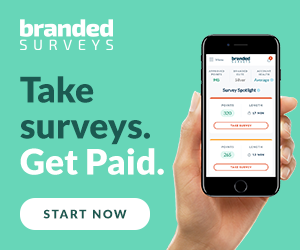There are a lot of great benefits of earning extra income. You can use it to pay off debt, go on vacation or treat yourself. If you want to turn your extra income into even more money, you can also start investing extra income.
But before you aimlessly start investing extra income you earn from doing online paid surveys with us, take a moment to learn how to invest first!
Know the Risks of Investing
Every investment comes with a risk. Of course, the ones that have the most risk usually come with the biggest gains – and the biggest losses.
Returns to rise and fall over time. For example, during the great recession, many saw their investments lose half their value overnight. Those who held onto their investments were rewarded with recoveries after a few years. The lesson to be learned is that when it comes to investing, focus on long-term versus short-term gains. You never want to sell your investments for less than what you paid.
One of the best parts of investing extra income from online surveys is that it’s a low risk. This is income you normally don’t have, so if you lose that money it’s not a catastrophe. You can wait it out and hopefully make your money back within a few years.
Educate Yourself
If you’re serious about investing the extra income you earn from online surveys, take the time to educate yourself so you know exactly how to invest for the best return. There are plenty of books and websites that will teach you how to evaluate and research potential stocks and mutual fund choices. Try to steer clear of gurus and companies who promise to help you achieve a high return on investment if you attend their events – they’re usually trying to sell you something.
Create a Play Account
Once you’ve learned a bit about investments, put your knowledge to the test. Without spending any real money, you can set up a play account to test investing in individual stocks. Google Finance, The Motley Fool, Yahoo Finance and other investment sites allow you to set up imaginary investment portfolios. You can use this tool to investigate and track stocks that interest you. This will allow you to see the ups and downs of the stock to determine if it’s the right investment for you. You can also use these tools to see exactly how to invest in real life.
Try a Robo-Advisor
If you don’t want to pick your own investments, a robo-advisor might be a good option. They use computer algorithms to handle your investments for you. They typically cost a low monthly fee and don’t require a minimum amount to open an account.
Robo-advisors are a smart way to begin investing extra money because they don’t require a ton of cash upfront. They also handle all the hard work! You should still keep an eye on your accounts – the robot may be doing the heavy lifting, but you’ll still need to supervise.
Robo-advisors can also help you learn how to invest. Some robo-advisor services offer free educational tools and customizable options for your portfolio if you want to experiment a bit.
Automate Your Investments
If you’re ready to start investing, the first step is figuring out how much you want to invest from the extra income you’ve earned. From there, you can set up automated contributions to your investments. This means a portion of your paychecks or extra income you earn is automatically added to your investments.
If you tend to spend money as soon as it hits your bank account, this is the easiest way to invest your money without thinking about it. You never see it in your bank account, so you forget it exists until you see your investments grow.
Use Investment Apps
If you like the idea of automated investments because you don’t know how to invest or you find it intimidating, you’re in luck. There are lots of apps that will automate your investments for you. Acorns, for example, rounds up your purchases on any linked debit or credit cards and invests the leftover change into a diverse portfolio of exchange-traded funds (EFTs). From there, it works just like a robo-advisor to manage your portfolio. There’s no minimum amount to open an account with Acorns; your account automatically starts investing once you reach $5 of rounded up money. You can also deposit additional money like extra income if you want to. Acorns charges $1 per month for standard investment accounts and $2 per month for individual retirement accounts.
Another investment app you can try is Stash. Stash teaches beginner investors how to create their own portfolio of individual stocks and EFTs. There’s a $5 account minimum with Stash and a small monthly fee for using the service.
Invest in a 401(k) or Other Retirement Plan
If your company offers a 401k plan – or you have your own retirement plan – this is the best investment you can make, especially if your employer matches your contribution. Since the match is free money, you have a guaranteed return on investment.
Most plans don’t have a minimum investment amount. Whether you want to start small or large, investing extra income you earn from taking online surveys is the perfect money to invest with an employer match.
Index Funds
If you’re looking for a low portfolio turnover, an index fund might be right for you. Index funds are a type of mutual funds that have a portfolio built to track or match a market index. This passive investment strategy uses tracking instead of professional portfolio management.
The market index is a series of investments that represent a certain portion of the market. For example, the Standard & Poor’s 500 Index (S&P 500) holds stocks for about 500 of the country’s largest companies. Index funds offer lower expense ratios and little to no minimum investment requirements.
Target Date Funds
This investment strategy works with a date in mind – for example, your retirement. Target date mutual funds automatically make investments with your target date in mind. This often requires the assistance of a professional manager to help you choose your investments. It may include a mix of stocks and bonds to help you reach your goal. As you get closer to your target date, more of your money will go towards bonds.
Exchange-Traded Funds
Exchange-traded funds work similarly to index funds. They use market index tracking and passive strategies for your investment. Instead of using a minimum investment, EFTs are regularly traded throughout each day, being sold to investors for a share price which can fluctuate. The share price is essentially the investment’s minimum and can range from $100 to much more. Since there is trading involved with EFTs, brokers usually charge a commission to sell or buy them, although you can find some commission-free ETFs.
Want to start investing extra income from taking online surveys? Then you’d better start raking in that additional cash. If you haven’t already started earning money with us, sign up for a Branded Surveys account today!













